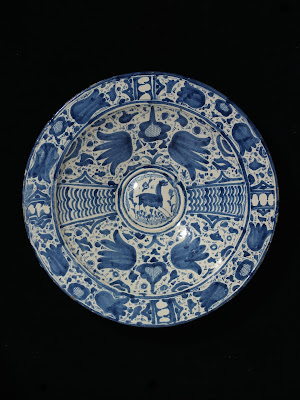Constanzia’s plate is the third one I’ve ever completed. The most important constraint upon the design was it had to be appropriate for her persona. Preferably, it should also look similar to the one made for Gabriel. I chose for this plate the only other blue on white plate fitting my “16thC, Spanish, Plate” search in Victoria and Albert museum (Figure 1). This dish is slightly simpler than the one made for Gabriel as the original has more solid fill shapes. The original comes from Seville or Valencia between 1550 and 1600. I think a significant part of the appeal of this plate is the llama in the centre. I eventually replaced the Llama with Constanzia’s device which is: Gules, a cross of Staniago, on a chief argent three crescents sable. Goto say, those crescents are a pain to paint. There is no image of the back of this plate in the V&A database.
Figure 1: The original: a tin-glazed earthernware dish with a height of 9.1cm and diameter of 47.3cm from Seville or Valencia between 1550 and 1600. (V&A)
Figure 2 shows the result of my labours. I rather like this plate because I’ve managed to replicate the key features of the original dish (the odd tulip shaped flowers). I think I was more successful balancing heavy features with thin background detail on this plate than I was with Gabriels.
Figure 2: Constanzia’s plate. The third I’ve ever painted.
I deliberately made some of the features not quite as skewed as in the original. There is a splodge visible in the original above the llama’s head which appears to be caused by dripping glaze. I’m lucky that by using three separate coats of glaze, I can avoid the slumping that would occur with a thick, single application. I’ve yet to decide if my lack of stroke marks is a good thing or a bad (Figure 3). I prefer solid fill shapes, however I know I’m not being true to the period example. In this case there appears to be no intentional shading so the lack of stroke marks is negligible.
Figure 3: a) Detail of the original dish showing stroke marks in the glaze and complicated background fill.
Instead of the central Llama, I had a choice: I could replicate Constanzia’s charge in blue or I could use her entire device. The first option would be fitting with the period examples (Figure 4) where a majority of devices and figures are in the base colour of the plate. In the end, I decided to use her full device as this plate is ment to be used in the SCA and we have the 2 points of difference rule for a reason. Due to her chosen colours, the device does stand out significantly but I rather like it.
As there is no image of the back of the original dish I found an image of a back of a dish of comparable quality and used it as the basis for the back of Stanzi’s plate. Figure 5 shows the rear of a dish made in Manises in the middle of the 16th century. It has many of the common features being leaf/feather decorations around the rim with circular fill as well as circular highlights and a spiderweb type fill in the centre of the base. I took some liberties when copying this design (Figure 6). I made the assumption that the dark lines on the rim are evidence of wear as the leaf design appears to continue under the brown. I also made some of the line work thicker and didn’t replicate some of the thinner ones. This is partly due to the shape of the bisque ware I’m working with and partly due to the fact fine circles are difficult when you have to go over them three times. I really liked the stippled circles in the middle of the spider web, so I replicated them. I quite like how the leaf border on Constanzia’s plate turned out.
Figure 5: The back of a tin glazed earthenware dish from Manises, mid 16th century. Height 6.1 cm, diameter 40.4 cm.
Figure 6: The back of Constanzia’s plate.





May I use this post and images for the St Florian newsletter?
ReplyDeleteSure, no problem.
ReplyDelete>8]